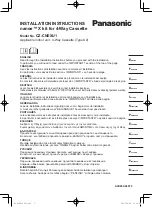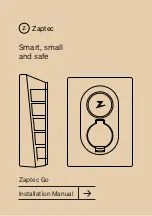
INSTALLATION:
(see the diagram)
•
Ensure all AC power is switched off.
•
Fix the bottom on the selected position with the screw
through the screw holes in the side of the sensor.
•
Connecting the power and the load to sensor as per the
connection-wire sketch diagram.
•
Switch on the power to test.
CONNECTION-WIRE DIAGRAM:
TESTING THE SENSOR SWITCH:
•
Slide the SENS knob: The first knob on “1”
position, the second knob on “0” position. Slide
the TIME knob: The first knob and second knob
on “0” position, the third knob on “1” position.
Slide the LUX knob: first knob on “0” position,
second and third knob on “0” position.
•
When you switch on the power, the light will turn
on immediately. 5 seconds later the light should
turn off automatically. If motion is detected after
this the light should turn on. This indicates normal operation.
•
If the motion sensor detects movement while the light is still on, it will reset the on-timer
delay from that moment.
•
Slide LUX knob, first and second knob on “0” position
,
the third knob on “1” position. If the
ambient light is < 5LUX (darkness), the sensor switch will go into motion sensing mode.
Note: When testing in daylight, you must slide LUX knob to (000) 2000lux to allow the
sensor to work.
INSTALLATION NOTES
:
•
This product must be installed & maintained only by a qualified, licensed electrician.
•
Install the product in a secure location that does not sway or vibrate.
•
Obstructive objects placed in front of the sensor may affect the sensing range.
•
Avoid installation near metal or glass surfaces as this may affect reception range.
•
For your safety, do not open case after installation (qualified electricians only).
•
Install a 6A switch or circuit breaker in-line with the switched load to prevent sensor damage
due to overloading.
TROUBLESHOOTING:
•
The connected load does not turn on:
a. Check the input power to the sensor. Ensure supplied voltage is between 220~240VAC.
b. Check to see if the indicator light is turned on after triggering – if it is, check the wiring to
the load.
c.
If the indicator light does not turn on after triggering, try increasing the value of the LUX
daylight sensor settings.
•
Poor motion detection sensitivity:
a. Ensure there are no objects between the sensor and the desired sensing location as
this could reduce the range.
b. Ensure that there are no other devices using the 5.8GHz band in close proximity to the
detector (eg: Wireless LAN, CCTV transmission equipment, etc.)
c.
Ensure the installation height is (ceiling) 2~6m / (wall) 1.5~3.5m.
•
The sensor does not turn off the load::
a. Check the TIME knob to ensure that the correct on-time delay has been selected
b. Ensure that there are no other devices using the 5.8Ghz band in close proximity to the
detector (e.g. Wireless LAN, CCTV transmission equipment, etc).
c.
Ensure that the power drawn by the load is less than 1200W for a resistive load and
300W for an inductive load.




















